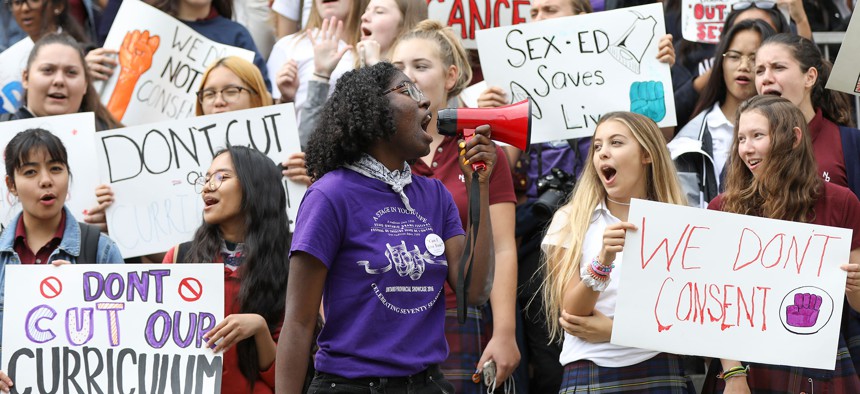Policy
Opinion: Sex education is the elephant in our classrooms
Outdated curriculums, erratic guidelines and unenforceable state standards contribute to Pennsylvania's educational shortcomings.

A woman uses a megaphone to lead the students of Notre Dame High School, an all-girl's Catholic school in protest of the province's repeal of the sex-ed curriculum and replacement of it with an outdated version. Toronto Star/Toronto Star via Getty Images
As students, we attend school expecting to learn all the necessary information to become empowered, independent adults. But what happens when a critical part of that education is missing? As illustrated here in Pennsylvania, a lack of sex education has dire consequences.
Anachronistic curriculums, erratic guidelines, and unenforceable state standards contribute in no small part to Pennsylvania's educational shortcomings. Policies put forth by the Pennsylvania Department of Education are tenuous and provide an inadequate framework for what sex education should look like. For instance, the word “contraceptive” isn't mentioned in state health and PE standards.
Sex education in Pennsylvania is not required to be comprehensive or medically accurate. Schools may also avoid discussing consent, gender, sexuality and safe relationships. Years of expert, peer-reviewed research has concluded that an effective curriculum must include information about safer sex practices instead of pretending that abstinence-based approaches are practical.
In a state devoid of educational mandates, local districts have complete control over what the curriculum looks like for their schools. Pennsylvania’s state profile by Sex Education for Social Change, a coalition working to advance education policy, shows that the percentage of Pennsylvania secondary schools teaching all 20 critical sex education topics is about 41%.
This lack of sex education only hurts our most vulnerable populations and perpetuates cycles of poverty. Philadelphia's adolescent pregnancy rate is significantly higher than the rest of Pennsylvania. Less than half of Philly students used a condom in their last sexual encounter, while the CDC’s Youth Risk Behavior survey shows that the percentage of sexually active students has increased since 2014.
A lack of sex education has broader ramifications as well. The socioeconomically affluent can afford the consequences of poor sex education; however, students in underfunded areas do not possess the same privilege. This disparity is likely to expand, especially in the wake of changing abortion policies nationwide.
Lower-income women are more likely to become teenage parents and less likely to complete high school, introducing economic roadblocks to success. Subsequently, children of teenage parents are less likely to graduate from high school and are more likely to become teenage parents themselves.
Black or Latina women are also more vulnerable to intimate partner violence, leading to longer-term downstream effects. Teens, especially those of lower socioeconomic status, are significantly more susceptible to interpersonal violence and sexual coercion.
Despite the perceived stigma, there are providential benefits to educating students on gender and sexuality. The confusion surrounding gender and sexuality contributes heavily to incredibly high rates of mental distress among queer teens.
Education on gender and sexuality shows children that queer identities exist and that it's OK to exist beyond the “norm.” Opponents of this curriculum argue indoctrination, but queer adults don’t exist in a vacuum – children begin to understand themselves during adolescence, and comprehensive sexuality education equips them with language to understand their identity. Talking about LGBTQ identities fosters a more inclusive environment and can ameliorate the isolation many queer students experience.
Research across years of health education has shown that comprehensive sex education has a definite positive impact on teenage pregnancy rates and STI transmission. And contrary to popular belief, the implementation of sex ed has shown no tangible increase in rates of sexual activity in adolescents. Research also shows that LGBTQ education reduces gaps in mental health between cisgender and LGBTQ students and can improve academic outcomes.
Plus, teens support a more comprehensive curriculum. Surveys conducted across populations show that most people favor comprehensive education and open discussion of these topics.
So why don’t we have sex education?
Educators and parents are responsible for the safety and well-being of their students and children, and as such, often conflate protection with sheltering. However, short-term “protection” through obfuscation leads to an inability to self-regulate and make responsible decisions in the long term; and teaches students that they should be afraid of their bodies and sexuality.
School boards approve curriculum at the district level, allowing us to advocate for an education devoid of political influence. Speak at your school board meetings, talk to your health teachers, and fight for a curriculum that represents the needs of an evolving population.
Anika Sapra is a student at Great Valley High School in Chester County, where she is involved with the Fund for Women and Girls, the Jane Project and State Sen. Carolyn Comitta's office. She is passionate about reproductive justice and works to further these goals through various institutions.
